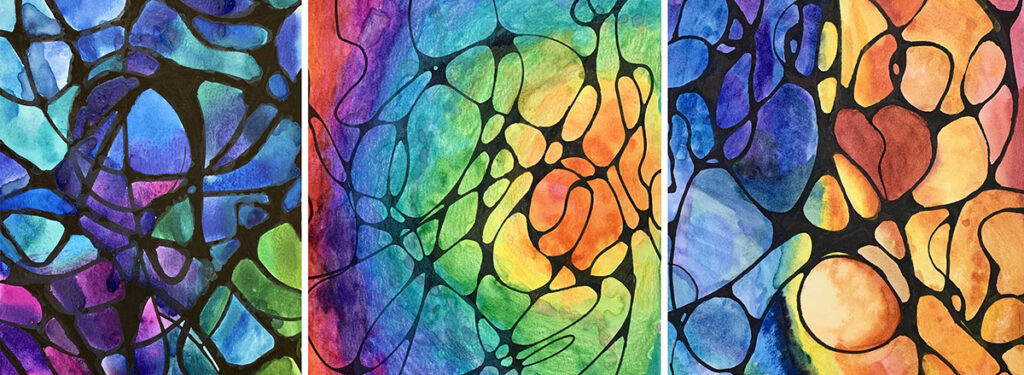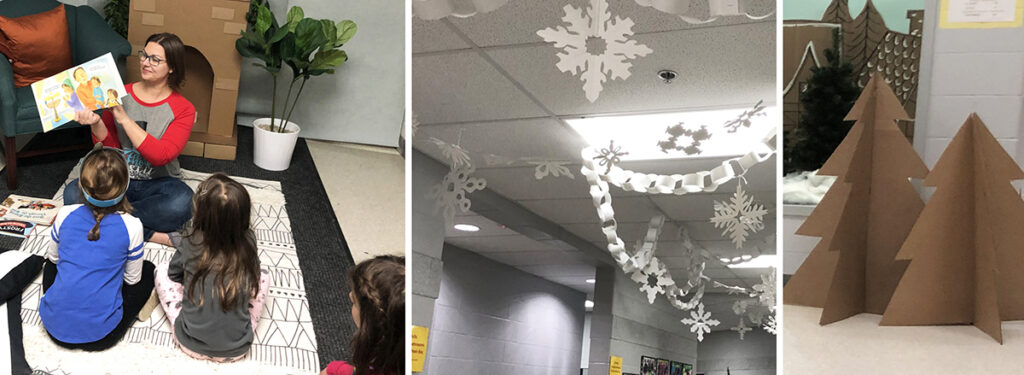December brings about festive cheer, white lights, and a moment for art educators to reflect on our purpose, practices, and inclusivity. As kids, we may have made paper stockings with fluffy white cotton glued to the top with our art teachers. But do these types of artmaking experiences have a place in art classes today?

We can agree our art rooms should be a safe place where all students are welcome. Considering what and how we teach in the month of December is an opportunity for us to question our instructional practices and exercise empathy. Stepping outside of ourselves and our own cultural traditions makes space for our students’ lived experiences. It also creates meaningful learning for all.
Take time to reflect on your intentions and practices.
Paula Liz is an elementary art teacher near Washington, DC, and a founder of Anti-Racist Art Teachers. She reminds us that our intent does not always equal our impact. Our intention might be to provide students with fun decorations that families adore and keep for a long time. Instead, our impact may be othering or excluding students who don’t celebrate our cultural holiday or don’t celebrate in the same way. There is also the real possibility that some students may not equate Christmas with joy and colorful lights but with a traumatic experience. Trauma-Informed Teaching reminds us to be aware of potential hidden circumstances that can be magnified around the holidays. This may include continued grieving over the loss of a loved one, abuse, or homelessness.
Linda Hoeptner Poling, an associate professor of Art Education at Kent State University, says, “Christmas is great… So are a lot of other world holidays.” Diwali, Ashura, Ramadan, Kwanzaa, Rosh Hashanah, Hanukkah—just to name a few! When we decorate our art rooms with Christmas trees and provide drawing prompts featuring Santa, we prioritize one holiday over others that may be culturally significant to our students. Amy Neiwirth, an intermediate art teacher in Ohio, says, “Kids are incredibly perceptive. They look to us and watch what we are doing all the time. Displaying a Christmas tree or hiding an elf amongst our supplies signals that Christmas is important in our art space.”
What about your own holiday traditions?
As we reflect, the critical thing to remember is that these conversations do not mean someone is taking our own holiday traditions away from us. We can celebrate with our friends and families joyfully and whole-heartedly. We are simply making room for our students and their unique developing identities.
So, what do we do instead? What is an art teacher to do in December that is not centered on Christmas? One way to get ideas is to listen to Rethinking Your Holiday Projects (Ep. 294).
Consider these artmaking experiences to spark enthusiasm, empathy, and an awareness of all that winter has to offer.
Let’s explore nature in winter!
It’s easy to gravitate to nature-inspired lessons in the warmer months. However, you can still find inspiration from the beautiful natural world even in December! The climate zone of your teaching situation adds to your understanding of what “December weather” looks like. Having these discussions may prompt meaningful accounts of a Saturday spent outdoors or a goal to see a snow flurry in real life.

Here are some winter nature ideas to get your creative lesson planning brains going:
- Pastel drawings focusing on the natural wonder of the northern lights.
- Snowman bowls formed with small “snowballs” of clay.
- Birch trees painted with watercolor and black ink.
- Snow globe drawings of favorite winter activities with crayon and watercolor resist.
- Underground homes of hibernating animals, drawn with lots of imagination.
What are some other December observances?
When we say “Happy Holidays” in December, we may assume this greeting includes multiple holidays. However, Christmas is centralized in mainstream American culture. Because the actual dates of Hanukkah change each year, our intention to include this Jewish holiday may result in an art project that is far outside the days of celebration. Linda Hoeptner Poling reminds us that there are a bunch of other inclusive observances in December to spark intriguing and inspiring work from our students.

Here are a few other special days to consider:
- December 3rd is International Persons With Disabilities Day.
Highlight artists with disabilities working in your community. Invite them to be guest speakers in your art room or highlight them as an artist of the month. - December 7th is National Letter Writing Day.
Students can write and illustrate letters to their heroes, near and far. Check out the series Unwritten Love Letters by Aminah Robinson. This artist used envelopes as a canvas for portraits of individuals she admired. Students create their own portraits of those they love and respect on envelopes. Alternatively, students compose artwork that fits into envelopes. - December 17th is National Underdog Day.
What an opportunity to discuss topics of social-emotional learning! Engage in conversation about what an underdog is in sports, culture, and art. Students devise their own unlikely superheroes.
Highlight student voice and choice in your art room.
Holidays are a joyful part of our cultural identity. Linda Hoeptner Poling reflects, “Part of honoring all students’ voices means helping each child find joy in their individual identity. Cultural traditions are a part of their identities.” When an artmaking experience focuses on student voice and choice, students are invited to share things about themselves in their work. Amy Neiwirth says, “If a student gravitates towards holiday subject matter on their own, the artmaking experience is more authentic and student-centered.”
Paula Liz adds, “No one is taking a holiday away from students. If they choose to share their family traditions in the form of artmaking, that is up to the students.” This can create meaningful learning opportunities for everyone when it’s time to share their work with peers. For example, a lesson in architecture may result in students adding Christmas trees to the exterior of their designs, giving them an opportunity to share their own cultural celebrations. The important part is that this is done by the students’ own choosing and is not required by the teacher.

We often use the strategy of emulating the style of an established artist to create a personal visual narrative. In December, a study on an artist like Joan Miró may result in students creating images about baseball, a family vacation, or lighting a menorah—all in his style. The key is that the narrative is the students’ choice to make.
How can we cultivate mental well-being?

This time of year can be busy and overwhelmingly exciting–regardless of cultural celebrations. The art room can be a safe space for students to explore their experiences and emotions. Amy Neiwirth suggests calming Neurographic art during December. The experience can be relaxing as students get lost in each curve and twist.
Try drawing activities that encourage students to share the emotions they are experiencing. If you need guidance on how to introduce this to your students, check out the digital series Drawing with Mr. J.
Create your own school-wide holiday.
We are not talking about Merry Xmas or Festivus but an inclusive and school community-based observance. For example, students at an Ohio elementary school celebrate Winter Fest. Throughout December, students create white paper snowflakes that hang from the school ceiling. Forests of cardboard trees take root in the halls. During an evening event, families visit the school in their pajamas. Large cardboard fireplaces welcome students for storytime with a staff member or community leader. These stories focus on winter themes and social-emotional learning. Hot cocoa and hands-on creation stations are available as families wish each other, “Happy Winter Fest!”

Just keep teaching art!
Sometimes the best thing to do in December is to just keep teaching art. Instead of breaking the flow of your curriculum, continue with the plans already in motion. Hilary Neu Carvitti teaches elementary art at a parochial school in Ohio. She intentionally does not provide Christmas artmaking lessons for her students. She shares, “Our time with our students is so limited. I try to be super aware of how I allot our time on skills and standards, packing in as much rich art content as possible. Content with cultural ties, historical figures, and new techniques.” Christmas-themed art experiences may be a disruption in the learning with which students are already engaging. It may be best to keep moving forward in your curriculum without these Christmas-themed projects.

The topic of holidays in the art room can be sensitive. We all have personal experiences that drive our decision-making and feelings during this time of year. However, students also have personal experiences that drive their choices and emotions. It is important to consider our purpose and impact when planning lessons this season.
Reflect on how our curricular decisions and classroom decor support or impede the art room as a safe space. When students are in our rooms, we want them to feel comfortable exploring and expressing themselves artistically as individuals. This may include depicting a favorite holiday tradition or a baseball game they attended with their uncle. Just as we do all year long, we can be more inclusive when we provide opportunities for student choice and expression.
For more articles like this, check out:
- What is the Role of Holiday Projects in the Art Room?
- 5 Ways to Prevent Your Classroom From Turning into a Holiday Gift Factory
- The Best Alternatives to Holiday Lessons (Ep. 018)
What kinds of activities do you engage your art students with during the month of December?
How does your classroom decor welcome all students to your space?
Magazine articles and podcasts are opinions of professional education contributors and do not necessarily represent the position of the Art of Education University (AOEU) or its academic offerings. Contributors use terms in the way they are most often talked about in the scope of their educational experiences.





